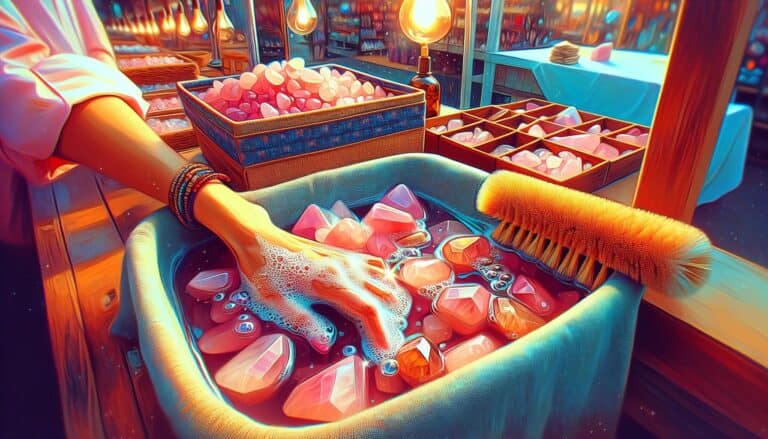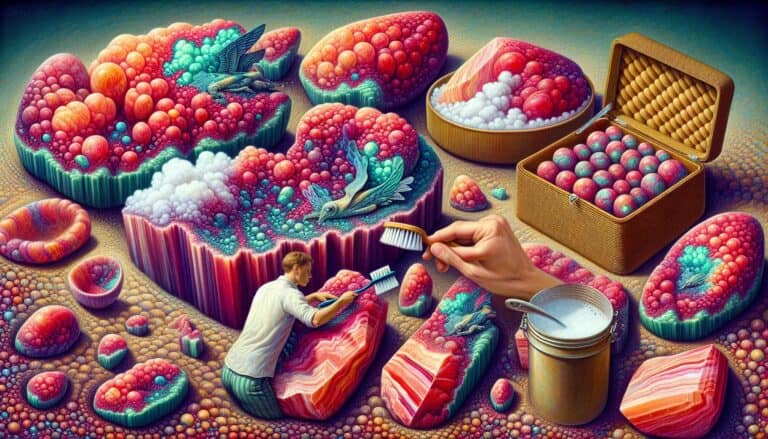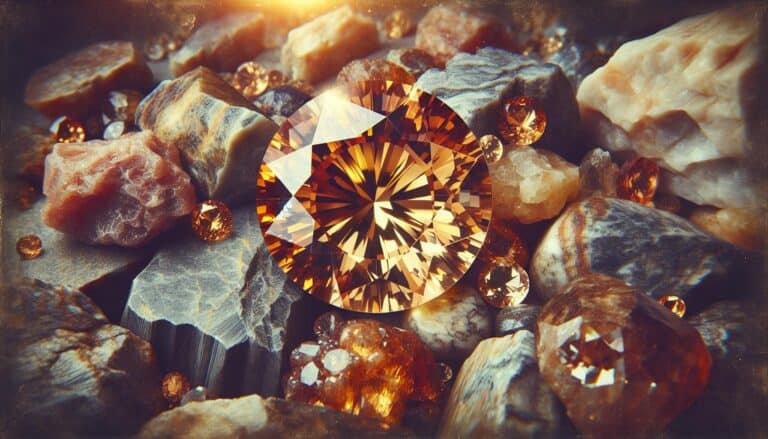Ever wondered about the value of that vibrant, eye-catching stone known as fluorite?
You’re not alone. Fluorite’s worth can vary widely, and figuring it out can be as complex as the stone’s stunning array of colors.
Whether you’re a collector, an investor, or simply curious, understanding the factors that influence fluorite’s price is key. From rarity to size, and color to clarity, each characteristic plays a crucial role in determining its market value.
Get ready to dive into the world of gemstones where you’ll uncover what makes fluorite a treasure and how its value is assessed.
Stick around, and you’ll become savvy about the worth of this mesmerizing mineral in no time.
Fluorite’s value is influenced by color, clarity, and craftsmanship. Vibrant colors and rare types like Rainbow Fluorite are more valued. Unique, well-crafted pieces fetch higher prices. Ensure authenticity through reputable sellers when buying.
What Is Fluorite?
Fluorite, also known as “fluorspar,” is a fascinating mineral that captures your attention with its luminous beauty. It’s composed of calcium fluoride and stands out in the mineral kingdom due to its wide range of vibrant colors. Its hues can include stunning purples, greens, yellows, and blues, often within the same specimen. This multicolored characteristic is not just appealing to the eye; it also contributes significantly to fluorite’s demand in various markets.
Renowned for its fluorescent properties—where the term “fluorescence” actually originates—fluorite can glow under ultraviolet light, adding to its allure among collectors and enthusiasts. In the realms of both collector interest and industrial applications, the stone’s fluorescence can be a standout feature, marking its identity as a truly unique substance.
Beyond its beauty, fluorite possesses practical uses. It’s an essential raw material in the manufacturing of a wide range of chemical, metallurgical, and ceramic products. Its importance is highlighted in the production of hydrofluoric acid, a precursor for numerous refined materials and commercial goods.
When considering its geological availability, fluorite is relatively common, but the occurrence of high-grade fluorite suited for specific industrial purposes is less frequent. The stone’s softness, graded at 4 on the Mohs scale of mineral hardness, necessitates careful handling and storage. This inherent softness, while a challenge, doesn’t detract from its value but rather emphasizes the need for optimal extraction and cutting methods to maintain the integrity of the mineral.
If you’re exploring the world of minerals, fluorite’s versatility and captivating appearance might lead you to delve deeper into understanding its worth. With its multipurpose applications and striking aesthetics, fluorite remains a celebrated gem in various sectors, with its value extending far beyond mere decoration.
Fluorite Prices: Factors That Affect Value

When you’re interested in adding fluorite to your collection or perhaps considering it for its industrial applications, it’s important to understand the key factors that influence its price.
Color, Clarity, and Cut Quality
Fluorite comes in a spectacular array of colors, each potentially impacting its overall worth. The most sought-after hues are intense and vivid, with rich purples, blues, and greens often fetching higher prices. Here’s how these three ‘C’s can affect fluorite’s value:
- Color: Pure and vibrant colors are more desirable. Emerald green and royal blue varieties tend to be pricier compared to pale or multicolored specimens.
- Clarity: Like many gemstones, the clearer the piece, the more you’re likely to pay. Inclusions can detract from the stone’s overall appearance and reduce its value.
- Cut Quality: A well-executed cut enhances the stone’s natural beauty and can increase its market worth. Artful faceting that maximizes the stone’s color and brilliance will also reflect in its price.
Market Demand and Availability
Market dynamics play a crucial role in determining fluorite’s value. It’s a game of scarcity and desire—rare colors and high-grade quality specimens are usually in high demand among collectors and industrial users alike. Think about this:
- High-Grade Material: Industrial-grade fluorite, especially that with over 97% calcium fluoride, is in continual demand. This high-grade material is scarcer and thus more valuable.
- Collector’s Appeal: For the collector, unique specimens with extraordinary colors or those from famous locales command premium prices.
- Market Fluctuations: Economic conditions can lead to fluctuations in mineral prices, and fluorite is no exception. Increased demand in the industry could mean a spike in its price.
Keep in mind that the availability of fluorite might change, but your knowledge of these factors will always be an asset in determining how much you should pay or expect when selling.
Understanding Fluorite: A Rare Gem

Fluorite stands out in the gem world not only because of its vibrant colors but also for its rarity. This uniqueness is a driving force behind its value and desirability.
The Rarity of Fluorite
Unique among minerals, fluorite’s rarity is due to its natural occurrence in a limited number of places globally. While you can find it in a range of environments, from sedimentary to metamorphic and igneous, the conditions necessary for the formation of the vibrant hues that characterize these sought-after gems are not common.
- Mining locales: The primary source of high-quality, colorful fluorite gemstones are certain well-known mines that have been able to produce gem-quality material.
- Variability: Each mine produces fluorite with distinct characteristics. Some churn out stones that boast a single radiant color, while others are known for multicolored specimens where several hues interact, enhancing their rarity and thus their value.
- Seasonal and environmental factors: Environmental factors such as weather and seasonal changes can impact mining operations, further influencing the scarcity of high-quality material.
Your search for quality fluorite could lead you to remote corners of the world where these unique conditions are met. But remember, rarity alone doesn’t confer value unless there’s significant demand for these beautiful stones.
Origins and Characteristics
Fluorite’s origins speak to its appeal. Known chemically as calcium fluoride (CaF2), it forms in a diverse collection of geological environments.
- Geological conditions: The crystals grow under a range of temperatures and pressures, often forming as a result of hydrothermal processes.
- Colors and sources: Fluorite’s kaleidoscopic color range is due to various trace impurities. Purple hues often hail from Illinois, USA, while vibrant greens originate in countries like China and England.
- Fluorescence phenomena: Many fluorite specimens can fluoresce under ultraviolet light, a characteristic from which the name ‘fluorite’ is derived. This unique property adds another layer of interest and distinction to the mineral.
As you delve deeper into the characteristics of this multifaceted gem, you’ll find the reasons behind its value are as varied as the colors it comes in. The market remains captivated by fluorite’s beauty and physical properties, leading to continued interest and varying price points for different specimens.
Fluorite Grading and Valuation
If you’re in the market for fluorite, understanding the grading system for this vivid mineral is crucial. Like diamonds and other gemstones, fluorite’s quality is evaluated on several key characteristics.
The Grading System for Fluorite
Several factors are taken into account when grading fluorite:
- Color: As you’ve learned, color significantly impacts value. The most prized fluorite boasts a deep, rich hue without zoning or color gradients.
- Transparency: Crystal clarity or transparency can amplify a fluorite’s allure. Stones that appear clear and unclouded are typically more valuable.
- Luster: A high-quality polish that results in a dazzling shine can elevate a fluorite’s appeal.
- Size and Weight: Larger pieces attract more interest due to their rarity but remember that quality should not be sacrificed for size.
It’s also essential to note that fluorite grades aren’t universally standardized. Different suppliers may use varying scales, so it’s vital to inquire about the grading criteria they apply.
Certification and Appraisal
When investing in high-grade fluorite, it’s wise to seek certification and appraisal from reputable organizations. These documents validate the authenticity and quality of your stone and can offer:
- Peace of Mind: Certification by gemological institutes ensures that your fluorite’s grade is recognized internationally.
- Value Assurance: An appraisal offers an expert’s valuation of your piece, which is invaluable for insurance and resale purposes.
To find a qualified appraiser, look for individuals affiliated with professional bodies such as the American Society of Appraisers or the National Association of Jewelry Appraisers.
It’s crucial to keep in mind that a certificate or appraisal adds to the cost, but it’s an investment in credibility and confidence, which are indispensable when dealing with valuable minerals like fluorite. Whether your interest lies in collecting or in using fluorite industrially, these valuations serve as a testament to the specimen’s worth, ensuring that you get what you pay for.
As you continue to delve into the intricacies of fluorite valuation, remember that each characteristic intricately weaves into its market value. The vividness of its color spectrum, the precision of its cut, and its overall condition fuse to determine its final worth. With this knowledge, you’ll be better equipped to make informed decisions and appreciate the true value of your fluorite.
Current Market Trends in Fluorite Pricing
The value of fluorite, as with any commodity, fluctuates based on current market demands and the economic environment. Keeping abreast of these trends is crucial as they directly impact fluorite’s pricing. If you’re looking to buy or invest in fluorite, understanding these trends will guide your decision-making process.
One key factor in today’s market is technology. With the advancement of tech products requiring fluorite components, particularly in optics and electronics, there’s been a surge in demand. Countries like China, Mexico, and South Africa are leading producers, but political and environmental regulations in these regions can heavily influence the availability and consequently, the price of fluorite.
Another major aspect affecting fluorite’s market price is its use in the metallurgical industry. Fluorite serves as a flux in steelmaking and aluminum smelting, where high-quality, high-purity grades are necessary. In response to increased production demands, prices for these top-tier fluorite grades often reflect the urgency of need within the industry.
For the gemstone market, aesthetic qualities like striking color and clarity dramatically bump up the price. The rarer the color, the higher the price you might expect to pay. For instance, Blue John, a rare variety of fluorite found only in Derbyshire, England, commands a premium due to its unique purple-blue hue and distinctive patterns.
Let’s delve into some specifics. Recent data suggests the following price ranges for fluorite:
| Fluorite Quality | Price Range (per carat) |
|---|---|
| Low-Quality Rough | $3 to $5 |
| Medium Quality Cut | $15 to $30 |
| High-Quality Cut | $40 and up |
Seasonal changes can also affect prices, with market activity generally picking up during holiday seasons when gemstones are in higher demand for gifts and decorations. It’s worth noting that these prices can vary significantly based on the factors previously mentioned such as size, color, and overall quality.
In light of these versatile usage scenarios and fluctuating supply chains, it’s evident that the pricing trajectory for fluorite remains dynamic. Keep your finger on the pulse by monitoring industry news, auction results, and joining forums where collectors and experts discuss the latest happenings in the fluorite market.
The Most Expensive Fluorite
When you’re in the market for fluorite, you might come across pieces that boast eye-popping price tags. Typically, these specimens are not just rare; they exemplify the utmost perfection in each of the value-determining factors mentioned earlier. The Most Expensive Fluorite can command prices well into the thousands of dollars, especially when they showcase a unique or deeply saturated color.
Such high-end specimens often come from famed locations known for their quality output. For example, the Rogerley Mine in England is renowned for its green fluorite, which displays an uncommon fluorescence in natural daylight. Stones from this mine, particularly those boasting both perfect clarity and intense color, can be some of the most sought after.
It’s also the rarity of certain colors that can drive up the price. Blue fluorite, for instance, is highly coveted due to its scarcity, and when combined with exceptional clarity and a flawless cut, the value can skyrocket. Here’s a glimpse at just how costly top-tier fluorite can get based on its attributes:
| Color | Clarity | Cut | Weight | Approx. Price Range |
|---|---|---|---|---|
| Deep Blue | VVS | Ideal | >100ct | $2,000 – $3,000 |
| Rich Green | VVS | Ideal | >100ct | $1,500 – $2,500 |
| Royal Purple | IF | Ideal | >100ct | $1,800 – $2,800 |
Aside from its natural attributes, the provenance of a fluorite specimen can add layers of value. Collectors and enthusiasts often seek out stones with a documented history or from mines with a legacy. So while you may notice significant prices attached to large, transparent pieces with vibrant hues, remember that the backstory of a piece can be just as valuable.
Keep in mind that while large, museum-quality pieces are certainly the most expensive, even smaller, high-quality fluorite specimens can fetch a premium. It’s all about the interplay of supply and demand, aesthetic appeal, and the stone’s inherent properties. Whether you’re a collector or an investor, understanding the market for exclusive fluorite specimens could be the key to making a wise purchase.
Buying Fluorite: Tips and Recommendations
When you’re in the market for fluorite, whether as a collector or an investor, it’s vital you’re armed with the right knowledge to make smart purchases. Here you’ll find a straightforward guide to acquiring high-quality fluorite, ensuring you get the best value for your money.
Where to Purchase High-Quality Fluorite
Seeking the perfect piece of fluorite requires knowing where to look. Gem shows and trade fairs are excellent places to start. They bring together a variety of vendors and provide a chance to see the stones up close. Additionally, specialized gemstone retailers, both brick-and-mortar and online, can offer curated selections with detailed descriptions and images.
Here are some tips when hunting for that perfect stone:
- Attend gem and mineral shows, where experts and enthusiasts converge.
- Look for authorized dealers who specialize in fluorite.
- Check out online marketplaces that have user reviews and ratings.
- Visit local jewelers who may have unique pieces or can offer bespoke services.
Remember, buying in person lets you inspect the stone’s quality firsthand, while shopping online might offer you a more extensive range to choose from. In either case, verify the seller’s credibility before making a purchase.
Ensuring Authenticity and Value
To ensure you’re getting genuine, high-quality fluorite, always ask for documentation of authenticity. A reputable seller will provide a certification or an appraisal that details the stone’s characteristics and quality. Additionally, consider the following:
- Ask for a certificate of authenticity from recognized gemological laboratories.
- Opt for vendors that offer money-back guarantees if the stone doesn’t match the description.
- Conduct a background check on the seller to confirm they’re reputable.
- Ask about the origin of the stone, as provenance can influence value.
Understanding the grading system of fluorite and looking for certification not only helps in affirming the stone’s quality but also aids in maintaining its resale value. Keep this in mind especially if you’re viewing fluorite as a long-term investment.
Conclusion: Buying & Selling Fluorite
Determining the true worth of fluorite comes down to your understanding of its grading system and the authenticity that certification provides.
Remember, the perfect stone is out there, and with the right knowledge, you’ll find it. Whether you’re browsing online marketplaces, visiting gemstone retailers, or exploring gem shows, always prioritize seller credibility. By doing so, you’ll not only secure a piece of nature’s splendor but also an investment that can maintain its value over time.
So go ahead, use these insights to your advantage, and add a stunning piece of fluorite to your collection with confidence.


![ND Rockhounding Sites in [year]: Treasures & Finds](https://observationhobbies.com/wp-content/uploads/2024/01/NXhSmnQX-d6GEwx7lYbig-768x439.jpg)




